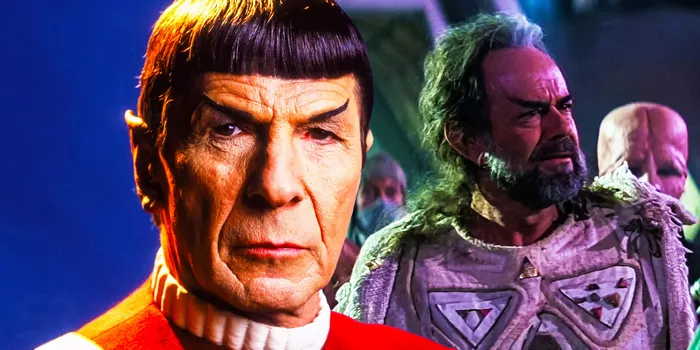In the annals of Star Trek’s cinematic history, one particular installment stands out for its audacious and controversial choice of antagonist: the Almighty Himself. Star Trek V: The Final Frontier, directed by William Shatner, boldly ventured into uncharted territory by casting God as the ultimate adversary, a decision that was met with a mix of fascination, skepticism, and outright dismay. As audiences grappled with the implications of pitting the crew of the USS Enterprise against a divine entity, the portrayal of the Almighty Villain in the movie raised profound questions about the intersection of science fiction and religious sensitivities, leading to a contentious discourse that reverberated far beyond the realms of the Star Trek franchise.
1. The God Conundrum: A Creative Misstep
The portrayal of God as the primary antagonist in Star Trek V marked a dramatic departure from the franchise’s traditional narrative arc, triggering a wave of controversy and skepticism among both die-hard fans and casual viewers. The concept of meeting God, while inherently intriguing, posed a significant challenge in navigating the delicate balance between science fiction storytelling and the diverse tapestry of religious beliefs held by audiences around the world. The decision to introduce such a monumental and deeply spiritual figure as a villain was perceived by many as a creative blunder, one that not only strained the boundaries of plausibility within the Star Trek universe but also risked alienating a significant portion of the franchise’s global fan base.
2. The Menacing Portrayal of George Murdock
Despite the inherent challenges posed by the character of God, George Murdock’s portrayal of the enigmatic deity known as Sha Ka Ree in Star Trek V exuded a palpable sense of menace and grandeur. Murdock’s commanding presence and gravitas lent a formidable aura to the character, imbuing the Almighty with an otherworldly charisma that resonated with audiences. His performance, laced with a subtle blend of authority and mystery, succeeded in capturing the essence of a being purportedly possessing omnipotent powers, thereby adding a layer of credibility and depth to the controversial portrayal of God within the Star Trek narrative.
3. Undermined Impact: Budget Constraints and Visual Effects
While George Murdock’s portrayal contributed to the character’s on-screen presence, the impact of Sha Ka Ree’s God was significantly undermined by substandard visual effects, primarily due to the constraints imposed by budget limitations. The depiction of a divine entity of such monumental significance necessitated an elaborate and visually captivating representation, one that could effectively convey the awe-inspiring majesty and transcendental nature of the Almighty. However, the technical shortcomings stemming from budget constraints hindered the film’s ability to fully realize the grandeur and mystique of God, ultimately diluting the impact of the character and impeding the audience’s immersive engagement with the narrative.
4. Box Office Woes: The Fallout of the Divine Encounter
In the aftermath of Star Trek V’s release, the decision to feature God as the central antagonist not only sparked a contentious debate within the Star Trek community but also had tangible repercussions on the franchise’s commercial success. Regrettably, the movie emerged as the lowest-grossing film in the Star Trek series, failing to resonate with audiences on the scale anticipated by the filmmakers. The inclusion of God as an antagonist, coupled with the film’s other shortcomings, created a perfect storm of critical dissatisfaction and lackluster box office performance, casting a shadow of uncertainty over the future of the beloved sci-fi franchise and nearly bringing an end to the cinematic voyages of the USS Enterprise.
5. Navigating the Intersection of Science Fiction and Faith
The controversial portrayal of God in Star Trek V underscored the complex interplay between science fiction storytelling and religious sensitivities, prompting a broader discussion about the boundaries of creative expression and the responsibilities inherent in navigating themes that intersect with deeply held spiritual beliefs. The decision to introduce a character of such profound religious significance within the context of a science fiction narrative exemplified the delicate balance required to engage diverse audiences while respecting their individual faiths and convictions. Star Trek V’s encounter with the divine not only highlighted the challenges of treading this precarious terrain but also emphasized the importance of fostering a nuanced and inclusive dialogue that acknowledges the diversity of perspectives within the realm of speculative fiction.
Conclusion
In the pantheon of cinematic controversies, the portrayal of God as the formidable antagonist in Star Trek V remains a poignant reminder of the risks and challenges inherent in weaving complex themes of faith and spirituality into the fabric of science fiction storytelling. While George Murdock’s compelling performance lent a measure of gravitas to the character of Sha Ka Ree’s God, the film’s struggles with budget constraints and the subsequent box office woes underscored the inherent complexities of reconciling creative vision with commercial viability. As the Star Trek franchise navigated the aftermath of this divisive creative choice, the legacy of Star Trek V’s divine debacle served as a cautionary tale, prompting a deeper reflection on the delicate equilibrium between creative exploration, audience reception, and the reverence owed to matters of faith and belief.

